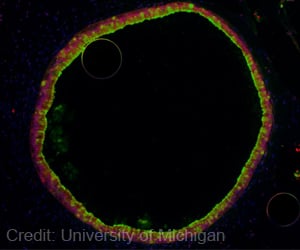Composition of the gastrointestinal flora drives the pathogenic immune response in the lungs during Transfusion Related Acute Lung Injury (TRALI).

‘A direct link between the gastrointestinal flora and lung disease in the setting of blood transfusions has been discovered.’





It is now becoming clear that the gastrointestinal flora affects multiple processes in health and several disease states but exactly how the microbes in our intestines affect lung diseases has been difficult to determine. The gastrointestinal flora is believed to play a role in both asthma and pneumonia but much more knowledge is needed, something stressed by the associate news editor of Nature Medicine, Shraddha Chakradhar, among others. The gastrointestinal flora drives the disease progression
The researchers made the discovery when studying TRALI (Transfusion Related Acute Lung Injury), a pulmonary complication that can occur after a blood transfusion and the leading cause of transfusion-related fatalities. The TRALI disease process, however, is incompletely understood and more insights into this disorder are needed in order to develop diagnostic and therapeutic approaches.
Sterile environments builds resistance to TRALI
The researchers compared two groups of mice where one group was kept in a strictly sterile environment, allowing the gastrointestinal flora to be minimally affected by external factors, whereas the other group was raised in a normal, less sterile environment.
Advertisement
The composition of the gastrointestinal flora was demonstrated to be significantly different between the two groups of mice, as was determined by genetic sequencing of the stool in collaboration with the Centre for Translational Genomics (CTG) of Lund University. In addition, when the researchers wiped out the gastrointestinal flora with several different types of antibiotics, they saw that the mice that suffered from TRALI no longer developed the disease.
Advertisement
The researchers then transplanted stool from mice that developed TRALI into mice that were resistant to TRALI. After the stool transplantation, the resistant mice were also able to develop TRALI, which confirmed the link between the composition of the gastrointestinal flora and the onset of TRALI.
Gastrointestinal flora analysis may be used for screening
The researchers still need to clarify which specific gut bacteria are directly involved but the knowledge that intestinal bacteria may affect the lungs is a critical finding which may facilitate diagnostics and the development of potential new drugs. Additionally, the ability to be able to easily assess the risk for TRALI due to analysis of gastrointestinal flora is equally important, argues the researchers.
"Knowing the composition of the gastrointestinal flora of people who will receive blood transfusions, an analysis which can be easily performed today, would allow you to assess who may be at increased risk for developing TRALI", says Rick Kapur.
The studies which were performed on mice, are clinically relevant, since the mouse model mirrors the human condition argue the researchers. "The TRALI model in mice is very similar to the condition in humans and the next step will be to validate these findings in humans. "It's not often that these types of findings in mice can lead directly to clinical studies in humans but that will be our aim" says John W. Semple.
Source-Eurekalert















